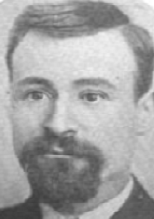Frederick Granger Williams II
(1853 – 1918)
Frederick Granger Williams was born March 29, 1853, in Salt Lake City, Utah. His parents were Dr. Ezra Granger Williams and Henrietta Crombie.
He was blessed by President Brigham Young in June of 1853. His mother commenced his schooling, teaching him at home, at the age of seven. He was born in a little white house to the rear of the Hotel Utah, just east of Temple Square. This house was still standing in 1925.
He married Amanda Burns on January 24, 1876, and was called that same year on a mission to Arizona on the Little Colorado River. In the fall of 1877 he moved to Ashley’s Fork, now Jensen, Utah. He was the first Presiding Elder in the Uinta Basin. In 1879 he returned to Ogden, the home of his parents, working for two years on the Oregon Short Line Railroad at Hams Fork, Wyoming.
In 1886 he started for Mexico by team, and got as far as Fairview, Utah. While living there he met Nancy Abigail Clement and married her in Salt Lake City on April 8, 1889. In December of that year he moved to Pleasant View. He was ordained a High Priest in February of 1890.
He moved to Mexico in August of 1890. At this time, he, together with several other men in his same circumstances, chartered two large freight cars to make the long journey south. In the end of one car the livestock was taken care of. In the other end were placed the farm implements. The number two car was partitioned off; on half held the household furnishings for four or five families. The families rode in this way to Denver, Colorado. There they changed trains, repacking all their belongings to travel on to Deming, New Mexico.
A short time before the family reached Denver, Flora May was stricken with spinal meningitis. By the time they arrived in Deming, she was very low. Frederick Granger telegraphed to Winslow Farr who was a member of their party but had gone ahead of the group. He had a place all ready for them when they arrived. Amanda, the sick girl’s mother, was in very delicate health also. Deming at this time was just a small railroad town out in the desert. Flora May was so ill it seemed her time had come to go. The family remained about a month and she was still very ill. Apostle George W. Teasdale passed through Deming on his way to the colonies to take charge of Mexican affairs for the Church. Frederick Granger told him of the child’s condition and he came to the house and with Frederick Granger and two or three other Elders, Apostle Teasdale placed his hands on the little girl’s head and gave her a blessing. He promised her that she would live to fill the measure of her creation and that she should be greatly blessed in life. The child began to mend so rapidly that within a very short time the family started on their way again to Colonia Diaz. Flor May grew to maturity and raised a family of her own.
While in Diaz, Amanda, Nancy and Elizabeth, wives of Frederick Granger Williams were all very ill with mountain fever. Elizabeth died. Amanda’s little girl Hazel also became very ill. She was six weeks old at the time. They gave her up for dead. They were washing her body for burial when she showed signs of life. The Elders administered to her and she immediately rallied and regained her health and lived to rear a lovely family.
The Williams moved to Colonia Dublan, 65 miles farther south of Diaz in 1891, and there Frederick Granger Williams found amply opportunity to be of service to the Mormon community in a variety of ways. As a young man he had been taught the rudiments of medicine by his father, Dr. Ezra G. Williams, who tried to make a doctor out of him. The son’s tastes, however, were for farming and raising livestock. He became a blacksmith, farmer and rancher. He did not permit his knowledge of medicine, however, to go unused. For many years he was one of the few trained health specialists available to the colonists. During his busy lifetime, he delivered many hundreds of babies.
In November, 1909, he moved with his family to Arizona, arriving in Binghampton (now part of Tucson) on December 15. In June, 1914, he started a ranch near Sonoita, Arizona, where he had homesteaded a quarter section of land. It was here, On January 19, 1918, while hauling a load of hay with his son Orin Granger, that he was pulled off the load and instantly killed. Two of his sons have presided over three such missions; Spanish American, Argentine and Uruguayan. A grandson, James A. Jesperson, is at this time laboring presiding over the Andes Mission, and his granddaughter, Leonor Brown, with her husband, Harold, presided over the Argentine Mission. Harold is at this time President of the Mexico City Stake.
Frederick Granger Williams grand- and great-grandchildren have spent well over an accumulated 100 years in missionary work among the descendants of Father Lehi in Latin America. Perhaps it was prophetic that the angel showed our progenitor, Dr. Frederick Granger Williams, the vision in which he saw Lehi’s landing place in South America. This vision was received in the Kirtland Temple which is constructed on land that he donated to the Church for that purpose.
Frederick Salem Williams, son
Flora May Williams, daughter
and Leonor Jesperson Brown,granddaughter
Stalwarts South of the Border, Nelle Spilsbury Hatch, page 778

